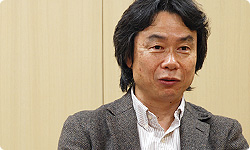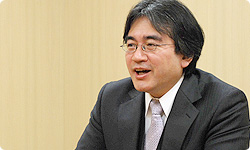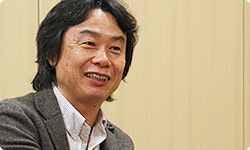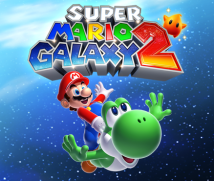2. What I Learned From the Producer
This year, 2010, marks the twenty-fifth anniversary of the release of the first Super Mario Bros. 6 And it’s actually been 14 years since the release of Super Mario 64. 6Super Mario Bros.: A side-scrolling platform game first released in Japan for the NES in September 1985. It was released in Europe in 1987.
Has it really been that long? Starting with Mario 64, this is the fourth 3D Mario game. Working on the series all this time, we’ve run across quite a lot of challenges.
What kind of challenges?
One was finding the right way of thinking about how to make Mario games. Take, for example, Mario Sunshine 7, which was a platform game using a water pump. 7Super Mario Sunshine: A 3D platform game released for the Nintendo GameCube in Europe in October 2002.
You could use the pump to shoot up into the sky.
That’s right. It’s a game that uses water, so we decided on a southern isle for the setting, and thought having it be a resort spot would be a good idea. And since it’s a southern island, you have to go there by plane. But if you go by plane, it would be weird for Princess Peach to go all alone, so we sent Toad along with her, and thought she needed an attendant, so Toadsworth is there, too. Princess Peach is there with her parasol open and her attendant standing by, but if that were all, it would be pretty lonely for a trip to a resort island!
The island needed to have inhabitants.
Right. You need inhabitants and other tourists. We had quite a discussion about that. We thought other tourists would kill the mood, but we at least needed inhabitants, so first we created the Piantas . We decided on the Piantas and the water pump, and only then began designing the enemies.
So you started making the enemies after you had first established the setting to a certain degree.
Right. And that was completely different to how we had made games up to that point. We’d started with Mario as a character who was not allowed to be hit by any enemies. But merely dodging enemies wouldn’t make a Mario game fun, so we started thinking about how Mario could beat his enemies. That led us to the idea of Mario Bros. 8, where you would hit the floor from underneath. 8Mario Bros.: An action game released in Japan in 1983 in an arcade version and later also for the NES.
That’s where the turtles came out, right?
Yeah. Because turtles are a good example if you think of something that’s flipped over. (laughs) We had made games that way up to a certain point, but it was a completely different approach to first decide on flying to a resort island where people called Piantas are living and only then start thinking about opponents. Something I started wondering about when we made the first Mario Galaxy was how we decided which characters are good and which ones are bad. Often when a new employee would draw a character, I would say, “That’s no good,” and they would say they didn’t know what was wrong with it. I would have to explain why it was no good, and I’d say that with the characters that appear in Mario, it’s very important that players be able to tell just by looking at them what their function is. It’s easy to understand once you put it into words, but that was the first time I had ever done it. We overcame a design problem as we made the first Mario Galaxy in that way, but another issue was story. I kept wondering if a story was really necessary for Mario games.

That’s been a hot topic ever since Mario Sunshine.
Yes. Koizumi-san9 was the director of Mario Sunshine and the first Mario Galaxy. This time, he oversaw Mario Galaxy 2 as producer. We’ve been a good team for quite some time. 9Yoshiaki Koizumi: In addition to developing the 3D Mario games, he has been involved with such games as Donkey Kong Jungle Beat and Flipnote Studio. He is at Nintendo’s Entertainment and Analysis Division’s Tokyo Software Development Department.
You guys have worked together since Mario 64, so you’ve been together about 14 years.
Yes. He came up with the scenario for Link’s Awakening 10, so he’s good at coming up with stories. 10The Legend of Zelda: Link’s Awakening: The first game in the Zelda series released for the Game Boy in Europe in December 1993. Then in January 1999, a remake named The Legend of Zelda: Link’s Awakening DX was released for the Game Boy Color in Europe.
In the session of “Iwata Asks” on The Legend of Zelda: Spirit Tracks, Tezuka-san11 said Koizumi-san is very romantic. (laughs) 11Takashi Tezuka: He has participated in development of numerous games, including games in the Super Mario, Yoshi and Animal Crossing series. He is General Manager of the Software Development Department of Nintendo’s Entertainment and Analysis Division.
Yes, he is. And he’s also good at animation. I’ve always watched over him to make sure he used those strengths but didn’t go overboard. Ever since Mario Sunshine, however, I’d felt there was something not quite natural about certain developments. I had, of course, talked about that with him all along, but when it came to certain central elements, there were areas we had each somehow avoided bringing up.
You had worked together for so many years, but some things were still unclear between you.
Right. When making the first Mario Galaxy, I had said Mario games didn’t need a story or movies, but before I knew it, there were quite a few movies and a substantial amount of story. When it comes to movies, you can pretty much stick them in at the end of development.
That’s when all the separate elements come together.

So at the end of development, I was like, “Huh? It’s getting more and more like Zelda!” (laughs)
After you had said there didn’t need to be a story! (laughs)
Right! Because I’d had that experience with the first Mario Galaxy, we talked beforehand this time about cutting out such elements, but I began to get the feeling during development that those things were not sufficiently cut off.
You said you would cut them out, but things just don’t work your way as you go along.
It wasn’t happening. I showed a version of the game to Tezuka-san and Nakago-san12 partway through development and they both said something was wrong. 12Toshihiko Nakago: He has supported development of Nintendo games such as those in the Super Mario and Zelda series ever since the days of the NES. He is president of SRD Co., Ltd.
When two guys who had worked on Mario13 for so long said something was wrong, you knew something had to change. 13Two guys who had worked on Mario for so long: Takashi Tezuka and Toshihiko Nakago talk about the Mario series in this “Iwata Asks” interview.
Yes. I had been keeping an eye on the action elements, and had checked the course designs, but I had mostly left the more theatrical elements to the team.
I see.
I knew I couldn’t leave the game as it was, so one Saturday afternoon, I met Koizumi-san outside the company building to have a long talk with him.
Oh, you told me about that the following week over lunch. You said you had talked with him for about four or five hours and figured out quite a lot. You seemed relieved, as if a fog that had been around for years had suddenly lifted. (laughs)
Yeah. (laughs) I hadn’t really talked to him that way for a long time. We were like a married couple that had grown used to each other and not talked heart-to-heart in the many years since their wedding suddenly having a long chat after the children have left the house. (laughs)

Ah ha ha! (laughs)
But talking over fundamental issues like Koizumi-san’s views on the importance of story, the function of stories in games and what kind of game Mario is, I learned something important.
And what was that?
I realised that whether it’s story or movies, it’s not about whether we need them or don’t need them. What’s most important is that the game resonates.
